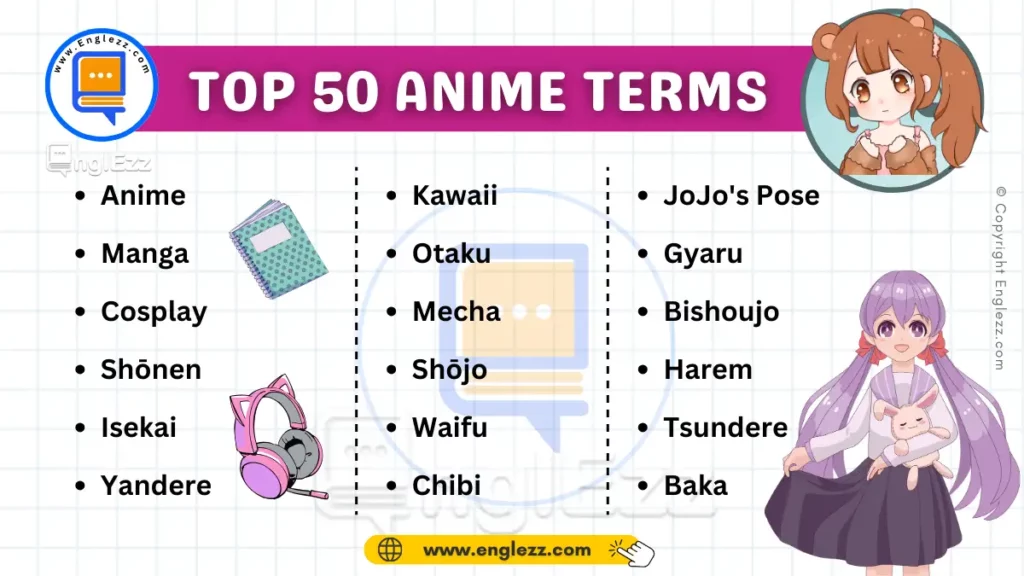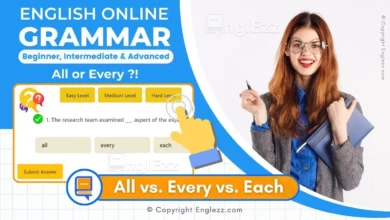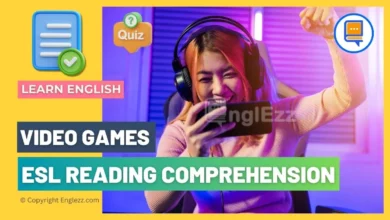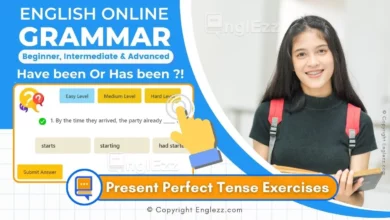Cartoons and anime have become an integral part of global pop culture, captivating audiences with their unique art styles, storytelling, and character development. Understanding the specialized language used in these mediums can enhance your viewing experience and deepen your appreciation for their intricacies. In this blog post, we will explore 50 of the most common Cartoons and Anime English terms.
Table of Contents
- 50 Cartoons and Anime English Terms Every Student Must Know
- #1. Anime 🎌
- #2. Manga 📚
- #3. Otaku 🤓
- #4. Cosplay 🎭
- #5. Mecha 🤖
- #6. Shōnen 👦
- #7. Shōjo 👧
- #8. Harem ❤️
- #9. Isekai 🌌
- #10. Waifu 💖
- #11. Senpai 👓
- #12. Kawaii 🌟
- #13. Tsundere 💢
- #14. Yandere 💔
- #15. Chibi 👶
- #16. Baka 🤪
- #17. OVA 🎬
- #18. Doujinshi ✏️
- #19. JoJo’s Pose 💪
- #20. Gyaru 💅
- #21. Moe 💗
- #22. Bishoujo 👸
- #23. Bishonen 🌸
- #24. Tsukkomi 🤨
- #25. Koi 🥰
- #26. Super Deformed (SD) 😆
- #27. Henshin 🔄
- #28. J-pop 🎵
- #29. Seiyuu 🎤
- #30. Fanservice 💋
- #31. Visual Novel 📖
- #32. Kanji 🈲
- #33. Kami 🗻
- #34. Chi 💫
- #35. Nendoroid 🧸
- #36. Onsen ♨️
- #37. Bishoujo Game 🎮
- #38. Otome Game 💕
- #39. Ramen 🍜
- #40. Idol 🎤
- #41. Yakuza 💼
- #42. Senpai-Kohai System 👩🎓
- #43. Magical Girl ✨
- #44. K-pop 💃
- #45. Drama CD 🎧
- #46. Eroge 🌹
- #47. Maho Shojo 🌈
- #48. Visual Kei 🎸
- #49. Tensei ⏳
- #50. J-Rock 🎸
- Cartoons and Anime English Terms Table
- Conclusion
50 Cartoons and Anime English Terms Every Student Must Know
Each term will be explained with its definition, phonetic transcription, and two illustrative examples to help you grasp its usage. Whether you’re a casual viewer or a dedicated fan, this guide will serve as a valuable resource in navigating the vibrant world of animated entertainment. Dive in and expand your knowledge of these dynamic genres!
#1. Anime 🎌
Definition: A style of animation originating in Japan, characterized by colorful artwork and fantastical themes.
Phonetic Transcription: /ˈænəˌmeɪ/
Examples:
- “Naruto” is a popular anime series known for its action-packed storyline.
- Many fans are eagerly awaiting the release of the new anime adaptation of the novel.
#2. Manga 📚
Definition: Japanese comic books or graphic novels that are often serialized in magazines.
Phonetic Transcription: /ˈmæŋɡə/
Examples:
- “One Piece” is a famous manga series with a huge following.
- She started reading manga in middle school and hasn’t stopped since.
#3. Otaku 🤓
Definition: A person with an intense or obsessive interest in anime, manga, or video games.
Phonetic Transcription: /oʊˈtɑːku/
Examples:
- As an otaku, he attends anime conventions every year.
- The store caters specifically to otaku enthusiasts.

#4. Cosplay 🎭
Definition: The practice of dressing up as a character from anime, manga, or other pop culture media.
Phonetic Transcription: /ˈkɒspleɪ/
Examples:
- She spent months preparing her cosplay outfit for the convention.
- Cosplay has become a popular hobby among anime fans.
#5. Mecha 🤖
Definition: A genre of anime that features giant robots, usually piloted by humans.
Phonetic Transcription: /ˈmɛkə/
Examples:
- “Mobile Suit Gundam” is a classic mecha anime series.
- The mecha battles in the show are incredibly detailed and exciting.
#6. Shōnen 👦
Definition: A genre of anime and manga aimed primarily at young males, often featuring action and adventure.
Phonetic Transcription: /ˈʃoʊnən/
Examples:
- “Dragon Ball” is a well-known shōnen anime that appeals to boys and men alike.
- The shōnen genre often includes themes of friendship and rivalry.
#7. Shōjo 👧
Definition: A genre of anime and manga aimed primarily at young females, often focusing on romance and relationships.
Phonetic Transcription: /ˈʃoʊdʒoʊ/
Examples:
- “Sailor Moon” is a beloved shōjo anime with a focus on magical girls and romance.
- The shōjo genre is known for its emphasis on character development and emotional storytelling.
#8. Harem ❤️
Definition: A genre where the protagonist is surrounded by multiple romantic interests, often of the opposite gender.
Phonetic Transcription: /ˈhærəm/
Examples:
- “High School DxD” is a popular harem anime with numerous romantic subplots.
- The harem genre typically features a single male character with several female admirers.
#9. Isekai 🌌
Definition: A genre where characters are transported to, reborn, or trapped in a parallel world or fantasy universe.
Phonetic Transcription: /ˌiːsəˈkaɪ/
Examples:
- Sword Art Online” is a famous isekai anime about players trapped in a virtual world.
- Isekai stories often involve characters gaining special powers or abilities.
#10. Waifu 💖
Definition: A term used to describe a fictional character from anime or manga that someone has a strong affection for.
Phonetic Transcription: /ˈwaɪfuː/
Examples:
- He has a poster of his favorite waifu on his wall.
- The concept of waifu is popular in anime fan communities.
#11. Senpai 👓
Definition: A term used to address or refer to one’s senior or mentor, often in a school or workplace setting.
Phonetic Transcription: /ˈsɛnpaɪ/
Examples:
- The younger students admire their senpai for their skills and leadership.
- She always looks up to her senpai for advice and guidance.
#12. Kawaii 🌟
Definition: A Japanese word meaning “cute” or “adorable,” often used to describe characters or objects.
Phonetic Transcription: /kɑːˈwaɪi/
Examples:
- The character’s kawaii design made her popular among fans.
- Many anime series feature kawaii characters with big, expressive eyes.
#13. Tsundere 💢
Definition: A character who is initially cold or hostile towards another character but gradually shows a warmer, more affectionate side.
Phonetic Transcription: /ˌtsʊnˈdɛreɪ/
Examples:
- The tsundere character often struggles to express their true feelings.
- In many anime, the tsundere trope is used to create romantic tension.
#14. Yandere 💔
Definition: A character who is obsessively in love and may resort to extreme measures to keep their loved one.
Phonetic Transcription: /ˈjændɛreɪ/
Examples:
- The yandere character is known for their possessiveness and unpredictability.
- Yandere traits are often used to create intense and dramatic storylines.
#15. Chibi 👶
Definition: A style of drawing characters in a small, cute, and exaggerated manner, often with oversized heads.
Phonetic Transcription: /ˈʃibi/
Examples:
- The chibi version of the character is popular in merchandise and fan art.
- Chibi characters are often used in humorous or adorable scenes.
#16. Baka 🤪
Definition: A Japanese word meaning “fool” or “idiot,” frequently used in anime and manga.
Phonetic Transcription: /ˈbɑːkə/
Examples:
- The character called his friend a baka after a clumsy mistake.
- The term baka is often used in a playful or teasing manner.
#17. OVA 🎬
Definition: Stands for “Original Video Animation,” referring to anime that is released directly to video rather than television.
Phonetic Transcription: /ˌoʊviˈeɪ/
Examples:
- The OVA series provides additional storylines and character development not found in the main show.
- Many fans look forward to the OVA releases for exclusive content.
#18. Doujinshi ✏️
Definition: Self-published works, often fan-created, that can include manga, novels, or art.
Phonetic Transcription: /dōˈdʒɪnʃi/
Examples:
- The artist released a doujinshi based on a popular anime series.
- Doujinshi are often sold at conventions and online marketplaces.
#19. JoJo’s Pose 💪
Definition: A term referring to the distinctive and dramatic poses featured in “JoJo’s Bizarre Adventure.”
Phonetic Transcription: /ˈdʒoʊˌdʒoʊz poʊz/
Examples:
- The character struck a classic JoJo’s Pose during the battle scene.
- Fans often recreate JoJo’s Pose in cosplay and fan art.
#20. Gyaru 💅
Definition: A fashion and lifestyle subculture in Japan characterized by trendy and flashy clothing, often featured in anime.
Phonetic Transcription: /ˈɡjɑːruː/
Examples:
- The character’s gyaru style includes brightly colored outfits and
elaborate hairstyles.
- Gyaru fashion often emphasizes bold and confident looks.
#21. Moe 💗
Definition: A term used to describe feelings of affection or adoration towards a fictional character, typically cute or endearing.
Phonetic Transcription: /moʊˈeɪ/
Examples:
- The moe character’s charm won over many fans.
- Moe elements are often used to evoke emotional responses in viewers.
#22. Bishoujo 👸
Definition: A term meaning “beautiful girl,” often used to describe attractive female characters in anime.
Phonetic Transcription: /biˈʃoʊdʒoʊ/
Examples:
- The bishoujo character is known for her stunning appearance and graceful demeanor.
- Bishoujo characters often play key roles in romance and fantasy genres.
#23. Bishonen 🌸
Definition: A term meaning “beautiful boy,” used to describe attractive male characters with delicate features.
Phonetic Transcription: /biˈʃoʊnən/
Examples:
- The bishonen character is admired for his elegant and charming looks.
- Bishonen characters are often featured in romance and drama anime.
#24. Tsukkomi 🤨
Definition: A character who reacts with disbelief or sarcasm to another character’s absurd statements or actions.
Phonetic Transcription: /tsʊˈkɒmi/
Examples:
- The tsukkomi character often serves as the straight man in comedic scenes.
- Tsukkomi responses help highlight the humor in dialogue.
#25. Koi 🥰
Definition: The Japanese word for “love,” often used in anime to describe romantic feelings.
Phonetic Transcription: /kɔɪ/
Examples:
- The character’s koi for her partner is central to the plot.
- Koi is a common theme in many romance and drama anime series.
#26. Super Deformed (SD) 😆
Definition: A style of drawing characters with exaggerated, small proportions for comedic effect.
Phonetic Transcription: /ˈsuːpər dɪˈfɔːrmd/
Examples:
- The SD version of the character added a humorous touch to the episode.
- Super Deformed characters often appear in comedic or light-hearted scenes.
#27. Henshin 🔄
Definition: A term meaning “transformation,” often used to describe characters changing into their superhero or magical forms.
Phonetic Transcription: /ˈhɛnʃɪn/
Examples:
- The hero’s henshin sequence is a highlight of the series.
- Henshin transformations are a key feature in many magical girl anime.
#28. J-pop 🎵
Definition: Japanese pop music that is often featured in anime openings and endings.
Phonetic Transcription: /ˈdʒeɪˌpɒp/
Examples:
- The anime’s J-pop theme song became a hit in Japan.
- Many anime fans enjoy the catchy tunes of J-pop music.
#29. Seiyuu 🎤
Definition: A Japanese term for a voice actor or actress who provides voices for anime characters.
Phonetic Transcription: /ˈseɪjuː/
Examples:
- The seiyuu for the main character has a long career in anime voice acting.
- Fans often follow the work of their favorite seiyuu across different series.
#30. Fanservice 💋
Definition: Content in anime that is designed to please or appeal to fans, often through provocative or humorous elements.
Phonetic Transcription: /ˈfænˌsɜːrvɪs/
Examples:
- The series included several fanservice scenes that generated a lot of discussion.
- Fanservice often plays a role in attracting and retaining viewers.
#31. Visual Novel 📖
Definition: An interactive game that combines storytelling with visual art, often featuring anime-style graphics.
Phonetic Transcription: /ˈvɪʒuəl ˈnɒvəl/
Examples:
- The visual novel had multiple endings depending on player choices.
- Visual novels are known for their rich storytelling and character development.
#32. Kanji 🈲
Definition: Chinese characters used in Japanese writing, often seen in anime subtitles and merchandise.
Phonetic Transcription: /ˈkɑːndʒi/
Examples:
- The character’s name is written in kanji on the merchandise.
- Kanji characters often appear in anime to convey important meanings.
#33. Kami 🗻
Definition: A Japanese word meaning “god” or “deity,” often used in anime to refer to divine beings.
Phonetic Transcription: /ˈkɑːmi/
Examples:
- The kami played a crucial role in the anime’s mythology.
- Kami characters are often depicted with great power and wisdom.
#34. Chi 💫
Definition: A term referring to the concept of energy or life force in various anime and manga.
Phonetic Transcription: /ʃiː/
Examples:
- The martial artist harnesses his chi to perform incredible feats.
- Chi is a common theme in anime that involves martial arts or magic.
#35. Nendoroid 🧸
Definition: A line of collectible figures that depict characters from anime in a cute, chibi style.
Phonetic Transcription: /ˈnɛndəˌrɔɪd/
Examples:
- The fan proudly displayed their nendoroid collection on the shelf.
- Nendoroid figures often come with interchangeable parts and accessories.
#36. Onsen ♨️
Definition: A Japanese hot spring or bath, often featured in anime as a relaxing or social setting.
Phonetic Transcription: /ˈɒnˌsɛn/
Examples:
- The characters enjoyed a visit to the onsen as part of their vacation.
- Onsen scenes in anime often highlight cultural aspects of relaxation.
#37. Bishoujo Game 🎮
Definition: A genre of visual novels or games that focuses on interactions with beautiful female characters.
Phonetic Transcription: /biˈʃoʊdʒoʊ ɡeɪm/
Examples:
- The bishoujo game features various romantic storylines and character routes.
- Many players enjoy bishoujo games for their detailed artwork and engaging narratives.
#38. Otome Game 💕
Definition: A genre of visual novels aimed at a female audience, featuring romantic interactions with male characters.
Phonetic Transcription: /ˈoʊtoʊmeɪ ɡeɪm/
Examples:
- The otome game allows players to pursue relationships with different male characters.
- Otome games are popular for their focus on romance and character development.
#39. Ramen 🍜
Definition: A Japanese noodle soup dish, often featured in anime as a beloved food.
Phonetic Transcription: /ˈrɑːmən/
Examples:
- The character frequently visits the local ramen shop in the anime.
- Ramen is often depicted as a comfort food in many anime series.
#40. Idol 🎤
Definition: A person, often young, who performs in music, dance, or acting, and is a common character type in anime.
Phonetic Transcription: /ˈaɪdəl/
Examples:
- The anime follows the journey of a young idol trying to make it big in the industry.
- Idol characters often face challenges and grow throughout their stories.
#41. Yakuza 💼
Definition: The Japanese organized crime syndicate, sometimes portrayed in anime as antagonists or complex characters.
Phonetic Transcription: /ˈjɑːkuːzə/
Examples:
- The yakuza boss was a central antagonist in the crime-themed anime.
- Yakuza elements add depth and intrigue to many anime plots.
#42. Senpai-Kohai System 👩🎓
Definition: The hierarchical relationship between seniors (senpai) and juniors (kohai) in schools or workplaces, commonly depicted in anime.
Phonetic Transcription: /ˈsɛnpaɪ ˈkoʊhaɪ ˈsɪstəm/
Examples:
- The senpai-kohai system influences interactions and relationships in many school-themed anime.
- Senpai often guides and mentors their kohai in various situations.
#43. Magical Girl ✨
Definition: A genre featuring young girls who transform into magical heroines to fight evil.
Phonetic Transcription: /ˈmædʒɪkəl ɡɜːrl/
Examples:
- Sailor Moon” is a classic example of the magical girl genre.
- Magical girl anime often includes themes of friendship and empowerment.
#44. K-pop 💃
Definition: Korean pop music that sometimes influences anime soundtracks and culture.
Phonetic Transcription: /ˈkeɪˌpɒp/
Examples:
- The anime featured a K-pop theme song that became popular among fans.
- K-pop and anime often intersect in fan communities and media.
#45. Drama CD 🎧
Definition: Audio dramas featuring voice actors performing scenes from anime or original stories, often included with anime releases.
Phonetic Transcription: /ˈdrɑːmə siː diː/
Examples:
- The drama CD provided additional backstory and character development for the series.
- Drama CDs are popular among fans for their immersive storytelling.
#46. Eroge 🌹
Definition: A genre of visual novels or games featuring adult content, sometimes influencing anime storylines.
Phonetic Transcription: /ˈɛroʊɡeɪ/
Examples:
- The anime was based on an eroge game with mature themes.
- Eroge elements are less common in mainstream anime but have niche audiences.
#47. Maho Shojo 🌈
Definition: A variation of “magical girl” anime with a focus on transformation and magical powers.
Phonetic Transcription: /ˈmɑːhoʊ ˈʃoʊdʒoʊ/
Examples:
- The maho shojo anime featured vibrant colors and enchanting transformations.
- Maho shojo characters often battle evil forces with their magical abilities.
#48. Visual Kei 🎸
Definition: A Japanese music genre known for its elaborate, androgynous fashion, sometimes depicted in anime.
Phonetic Transcription: /ˈvɪʒuəl keɪ/
Examples:
- The character’s visual kei style added to the anime’s unique aesthetic.
- Visual kei music influences many anime themes and character designs.
#49. Tensei ⏳
Definition: A term meaning “reincarnation,” often used in anime where characters are reborn into different worlds.
Phonetic Transcription: /ˈtɛnseɪ/
Examples:
- The protagonist’s tensei journey begins after his death in the real world.
- Tensei anime frequently explore themes of second chances and new beginnings.
#50. J-Rock 🎸
Definition: Japanese rock music featured in anime soundtracks and opening/ending themes.
Phonetic Transcription: /ˈdʒeɪ ˈrɒk/
Examples:
- The anime’s opening theme was performed by a popular J-rock band.
- J-rock adds energy and excitement to anime series through its dynamic sound.
Cartoons and Anime English Terms Table
| Anime | Kawaii | JoJo’s Pose |
| Manga | Otaku | Gyaru |
| Cosplay | Mecha | Bishoujo |
| Shōnen | Shōjo | Harem |
| Isekai | Waifu | Tsundere |
| Yandere | Chibi | Baka |
| OVA | Doujinshi | JoJo’s Pose |
| Senpai | Koi | Super Deformed |
| Henshin | J-pop | Seiyuu |
| Fanservice | Visual Novel | Kanji |
| Kami | Chi | Nendoroid |
| Onsen | Bishoujo Game | Otome Game |
| Ramen | Idol | Yakuza |
| Senpai-Kohai | Magical Girl | K-pop |
| Drama CD | Eroge | Maho Shojo |
| Visual Kei | Tensei | J-Rock |
Conclusion
Cartoons and anime offer a rich tapestry of genres and terms that contribute to their unique storytelling and artistic style. By familiarizing yourself with these 50 common English terms related to cartoons and anime, you can enhance your understanding and enjoyment of these dynamic media.
From the cute and endearing to the dramatic and intense, each term provides insight into the diverse world of animated entertainment. Whether you’re a dedicated fan or just starting to explore the genre, this guide will help you navigate and appreciate the many facets of anime and cartoons.
Embrace the colorful world of anime vocabulary, and let it deepen your appreciation for the art and stories that captivate millions around the globe.









Hello I really like your writing so a lot to share! we keep up a correspondence extra approximately your post on AOL I need an expert in this house to unravel my problem May be that is you Taking a look ahead to see you!